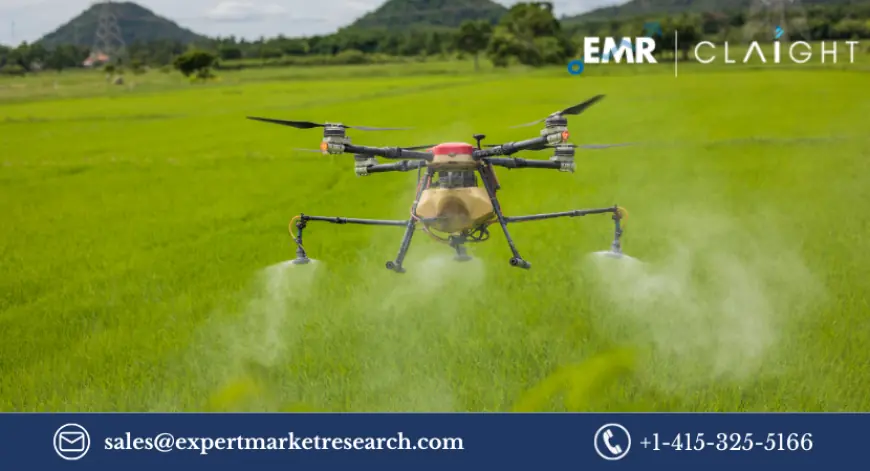Precision Agriculture Market Size, Share & Trends, Growth 2024-2032
Precision agriculture (PA) involves using advanced technologies like GPS, IoT (Internet of Things), AI (artificial intelligence), drones, and sensors to monitor and manage agricultural practices more efficiently.

The precision agriculture market is transforming the global agricultural landscape by leveraging advanced technologies to optimise farming practices. With increasing demand for food production, rising concerns about sustainability, and advancements in technology, precision agriculture is becoming a critical tool for farmers worldwide. This article provides a comprehensive overview of the precision agriculture market, including its segmentation, size, share, growth outlook, opportunities, challenges, and a competitive analysis of the leading players.
Introduction to the Precision Agriculture Market
Precision agriculture (PA) involves using advanced technologies like GPS, IoT (Internet of Things), AI (artificial intelligence), drones, and sensors to monitor and manage agricultural practices more efficiently. By integrating data-driven solutions, precision agriculture helps farmers increase productivity, reduce waste, and optimise resource use such as water, fertilisers, and pesticides.
Precision Agriculture Market Segmentation
The precision agriculture market is segmented based on technology, application, farm size, and region. Let’s explore these segments in detail.
By Technology
Precision agriculture involves various technologies that help farmers monitor and manage their crops and equipment.
Global Positioning System (GPS): GPS technology enables accurate mapping and field-level navigation, improving the efficiency of tractors and harvesters.
Remote Sensing: Technologies like satellites and drones help in collecting real-time data on crop health, soil moisture, and nutrient levels.
Variable Rate Technology (VRT): This technology allows farmers to apply inputs like fertilisers and pesticides at variable rates depending on the needs of specific areas within a field.
Internet of Things (IoT): IoT devices, such as sensors and connected devices, provide real-time data for farm management systems.
Artificial Intelligence (AI) and Machine Learning (ML): AI-driven algorithms help analyse large datasets for predictive analysis, improving decision-making processes.
By Application
Crop Management: Includes the use of sensors and drones for monitoring crop health, identifying diseases, and optimising irrigation.
Soil Management: Involves precision irrigation systems and soil sensors for maintaining optimal soil conditions.
Weather Tracking: Uses climate data and weather forecasting tools to make farming decisions based on the anticipated weather patterns.
Farm Labour Management: Technologies like robotics and AI assist in automating labour-intensive tasks such as planting, weeding, and harvesting.
Get a Free Sample Report with Table of Contents:
https://www.expertmarketresearch.com/reports/precision-agriculture-market/requestsample
By Farm Size
Small Farms: Precision agriculture solutions help small-scale farmers improve productivity while reducing operational costs.
Large Farms: Larger farms benefit from automation, drone usage, and advanced irrigation systems to manage vast areas with minimal manpower.
By Region
North America: Dominates the precision agriculture market due to strong adoption of advanced agricultural technologies in the U.S. and Canada.
Europe: Driven by EU’s support for sustainable farming practices and increasing investments in agri-tech.
Asia-Pacific: Rapid adoption of precision farming techniques in countries like China and India is fostering growth in this region.
Rest of the World: Emerging markets in Africa and Latin America are also adopting precision agriculture for better food security.
Precision Agriculture Market Size and Share
Market Size
The precision agriculture market was valued at approximately USD 7.3 billion in 2023 and is expected to grow at a CAGR of 13.5% from 2024 to 2032, reaching an estimated value of USD 26.1 billion by 2032.
Market Share
North America: Holds the largest market share, contributing to over 35% of the global market, primarily due to early adoption and technological infrastructure in the U.S. and Canada.
Europe: Accounts for 28% of the market, with strong growth in countries like Germany, France, and the UK due to government initiatives and sustainability goals.
Asia-Pacific: The fastest-growing region, with a projected CAGR of over 15%, driven by large agricultural sectors in China and India.
Latin America and Africa: These regions are gradually adopting precision agriculture techniques, with substantial growth potential.
Precision Agriculture Market Outlook
The precision agriculture market outlook remains highly optimistic, supported by ongoing advancements in agricultural technology and increased awareness of sustainable farming practices. The market is expected to expand as more farmers worldwide adopt smart farming solutions to increase crop yield and reduce input costs.
Key drivers contributing to the positive outlook include:
Technological Advancements: Continuous improvements in drone technology, AI, IoT, and remote sensing devices.
Government Initiatives: Subsidies and policy support aimed at promoting sustainable agricultural practices.
Climate Change Awareness: Growing concerns about climate change and its impact on crop production, leading to the adoption of precision farming to ensure food security.
Consumer Demand for Sustainable Food: Increasing demand for sustainably grown food products is encouraging farmers to adopt precision agriculture.
Precision Agriculture Market Growth
The precision agriculture market growth is being fuelled by several factors:
Rising Demand for Food: The global population is expected to reach 9.7 billion by 2050, increasing the demand for food. Precision agriculture helps farmers meet this demand by improving crop yield and resource efficiency.
Sustainability Goals: With the focus on sustainable farming, technologies that reduce chemical use, conserve water, and minimise environmental impact are seeing growing adoption.
Adoption of Automation: Automation and robotics are increasingly being used in large-scale farming operations to reduce labour costs and enhance operational efficiency.
Advancements in Data Analytics: AI and machine learning are enabling farmers to process large volumes of data, resulting in more informed decisions and better crop management.
Precision Agriculture Market Opportunities and Challenges
Opportunities
Expansion in Emerging Markets: There is significant growth potential in emerging economies like India, China, Brazil, and Africa, where agricultural sectors are adopting precision farming technologies to boost productivity.
Integration of Advanced Technologies: The incorporation of AI, machine learning, and blockchain can enhance farm management systems, improving efficiency and transparency in the supply chain.
Government Incentives: Governments around the world are providing subsidies and support to encourage the adoption of precision agriculture technologies.
Smart Irrigation Systems: As water scarcity becomes a global issue, smart irrigation systems are gaining popularity, presenting an opportunity for growth in the precision agriculture sector.
Challenges
High Initial Costs: The upfront costs of implementing precision agriculture technologies can be a barrier for small-scale farmers.
Lack of Skilled Labour: The need for trained personnel to operate and manage advanced technologies can pose a challenge, particularly in developing regions.
Data Security and Privacy: The integration of IoT and cloud-based platforms raises concerns about data security, which may deter some farmers from adopting these technologies.
Infrastructure Limitations: In rural or less-developed areas, inadequate internet connectivity and infrastructure can hinder the effective use of precision agriculture tools.
Competitor Analysis
The precision agriculture market is competitive, with numerous companies focusing on technological innovation and strategic partnerships to strengthen their market position. Some of the leading companies include:
John Deere: A global leader in agricultural machinery and precision farming solutions. Their "John Deere Operations Center" allows farmers to manage operations using data-driven insights.
Trimble Inc.: Offers a wide range of precision agriculture solutions, including GPS-guided equipment and field mapping services.
Raven Industries: Known for its innovative precision ag solutions such as variable rate technology and autonomous vehicles for field management.
Other : In addition to the companies listed above, several other firms are playing crucial roles in shaping the precision agriculture landscape:
Read Full Report with Table of Contents:
https://www.expertmarketresearch.com/reports/precision-agriculture-market
Media Contact:
Company Name: Claight Corporation
Contact Person: James Jon , Business Consultant
Email: sales@expertmarketresearch.com
Toll Free Number: US +1-415-325-5166 | UK +44-702-402-5790
Address: 30 North Gould Street, Sheridan, WY 82801, USA
Website: www.expertmarketresearch.com
What's Your Reaction?
 Like
0
Like
0
 Dislike
0
Dislike
0
 Love
0
Love
0
 Funny
0
Funny
0
 Angry
0
Angry
0
 Sad
0
Sad
0
 Wow
0
Wow
0












































